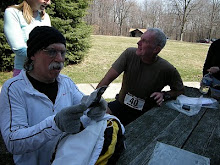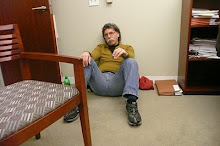JPhoto
The postage sized lawn set along the quietly narrow city street with cars parked half cocked upon its aged cement chipped sidewalk, nestled two blocks North of old Main Street lined with art deco designed store facades faced with large shiny opaque colored kitchen table sized glass tiles of forest green or black framed around large plate glass windows, nested a series of 1920 era row houses with sidewalk stoops. In the middle of the two-storied, shotgun built row homes was one with a bowling ball grotto protected by the rickety decades-old painted chain link fenced front yard.
Being a regular passersby, he wondered who created this sidewalk alter of St. Christopher standing before three concentric circles of 33 colored bowling balls. Was it a Polish kapliczki? Or, could it be an Italian yard shrine?
Come winter’s snowfalls, there will be concentric mounds of sparkling crystalliferous snow capping the unique shrine. The religious statue standing above the to-be-expected elderly fabricated grotto layered under the white snow covered blanket will lie frozen hidden in waiting, like a child under his warm bed sheet reluctant to step outside into the room’s cold air, until the spring’s melting thaw that will, once again, reveal itself among the blooming white and yellow crocuses, bluets and purple hyacinths.
But, today it is summer and the thinly rimmed yard of gravel and stone sprout not a single weed or blade of grass, yet not a single soul has ever been seen on bended knee to pluck out the garden invaders. Lining one edge of the narrow yard was a row of more bowling balls, as if they had popped up from beneath the alley’s varnished wooden lanes lined in a chain, one bumped up against the other, waiting for the next hand to reach down with the familiar three finger pronged grip slipping into the corresponding polished holes, lifted, then gently cradled by the other hand, in preparation for another explosive tour de’ force toward the head pin.
His reason for knowing more than he should about this relic of a place was because every working day he passed the row home early in the morning on his way to work and, later in the afternoon, sometimes in the drawing darkness of day, he would pass it again on his way home.
Occasionally, he would stop at the nearest opposite corner, sit on the curb watching the bowling ball grotto’s sacred ground for any stirring of life. He might wait for as along as thirty minutes, talk on his mobile phone to pass the time, and attempt to look harmless, yet never saw a single person come to the window to peer through the lacy curtain sheers, or crack open the heavy wooden front entry to see if she was there gazing back. His mind framed the dweller as an old woman dressed in warn black clothing bought 50 years ago from a local dressmaker.
There were moments when he stopped in front of the fence wondering what the lonesome person inside might say about the kapilczki, and if it was her work of art; or, if its creation was done by a deceased loved one and remains as a living memorial to that life partner.
But, the front door never opened. The stoop never sat upon. The curtain never parted. A window never raised. A light never turned on. The home appearing without the rustling of life. The individual remaining quietly inside sitting reading her bible, and praying the rosary beads.
The yard shrine and home left alone. Honored by neighbors. Respected by strangers. And, watched over by an unassuming bowling ball grotto. (611 words)






